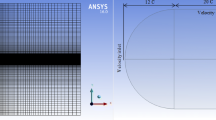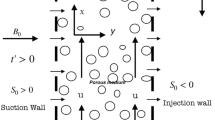Abstract
In order to investigate the aerodynamics of a high speed low pressure turbine works in high Mach number and low Reynold number environment, the effect of freestream turbulence (FST) on the boundary layer development on the high speed low pressure turbine under different Reynolds numbers (Re) is numerically investigated. Large eddy simulation is adopted here with a subgrid scale model of Wall Adapting Local Eddy viscosity (WALE). Cases with Re ranging from 100 000 to 400 000 under an exit Mach number (Ma) of 0.87 have been considered at low and high FST levels. A low Ma case (0.17) under very low Re has also been studied under both low and high FST. It is found that higher Re or FST level leads to earlier transition. Re has a greater effect than FST on the development of boundary layer. The effect of FST on the boundary layer depends on the Re. The boundary layer development shows totally different behaviors under different Ma. A separation bubble could be formed under low Ma while no attachment could be detected under high Ma. The FST has a stronger effect on the separated boundary layer under low Ma, which could eliminate the separation in the present study. For all the cases under low FST, the Kelvin-Helmholtz instability is the dominate mechanism in the transition process. For the low Ma case with high FST, the streamwise streaks play a dominant role in the transition process. For the high Ma cases with high FST, both the streamwise streaks and Kelvin-Helmholtz instability work in the transition process. The streamwise streaks play a more important role when the Re increased.
Similar content being viewed by others
Abbreviations
- C :
-
chord length/mm
- C p :
-
pressure coefficient
- C x :
-
axial chord length/mm
- FST:
-
freestream turbulence
- f :
-
frequency
- H 12 :
-
Shape factor
- Ma :
-
Mach number
- p s :
-
Static pressure/Pa
- p t :
-
Total pressure/Pa
- Re :
-
Reynolds number
- s :
-
pitch/mm
- St :
-
Strouhal number
- V :
-
Velocity
- Zw :
-
Zweifel number
- β 1 :
-
Inlet angle/(°)
- β 2 :
-
Outlet angle/(°)
- β s :
-
Stagger angle/(°)
- τ wall :
-
Wall shear stress
- δ :
-
displacement thickness
- θ :
-
momentum thickness
- e:
-
edge of boundary layer
- in:
-
inlet
- out:
-
outlet
- s:
-
separation
References
Hodson H.P., Howell R.J., The role of transition in high lift low-pressure turbines for aeroengines. Progress in Aerospace Sciences, 2005, 41(6): 419–454.
Wisler D.C., The technical and economic relevance of understanding blade row interactions effects in turbomachinery. Von Karman institute for fluid dynamics lecture series, 1998, February.
Hourmouziadis J., Aerodynatmic design of low pressure turbines. AGARD Lecture Series, 1989, 167: 120–133.
Hatman A., Wang T., Separated flow transition. Part1. Experimental methodology and mode classification. ASME Turbo Expo 1998, Stockholm, Sweden, 2–5 June 1998, paper No. 1998-GT-461.
Hatman A., Wang T., Separated flow transition. Part2. Experimental results. In: ASME Turbo Expo 1998, Stockholm, Sweden, 2–5 June 1998, paper No. 1998-GT-462.
Hatman A., Wang T., Separated flow transition. Part3. Primary modes and vortex dynamics. ASME Turbo Expo 1998, Stockholm, Sweden, 2–5 June 1998, paper No. 1998-GT-463.
Hatman A. and Wang T., A prediction model for separated-flow transition. ASME Turbo Expo 1998, Stockholm, Sweden, 2–5 June 1998, paper No. 1998-GT-237.
Volino, Ralph J., Separated flow transition under simulated low-pressure turbine airfoil conditions—part 1: mean flow and turbulence statistics. Journal of Turbomachinery, 2002, 124(4): 645.
Simoni D., Lengani D., et al., Inspection of the dynamic properties of laminar separation bubbles: free-stream turbulence intensity effects for different Reynolds numbers. Experiments in Fluids, 2017, 58 (66): 1–14.
Taniguchi H., Sakai H., Funazaki K., Effects of free-stream turbulence on bypass transition of separated boundary layer on low-pressure turbine airfoils. Proceedings of 3rd Asian Joint Workshop on Thermophysics and Fluid Science, Matsue, Japan, 2010.
Spalart P.R., Strelets M.K., Mechanisms of transition and heat transfer in a separation bubble. Journal of Fluid Mechanics, 2000, 403: 329–349.
Yang Z., Abdalla I.E., Effects of free-stream turbulence on large-scale coherent structures of separated boundary layer transition. International Journal for Numerical Methods in Fluids, 2010, 49(3): 331–348.
Yang Z., Abdalla I.E., Effects of free-stream turbulence on a transitional separated-reattached flow over a flat plate with a sharp leading edge. International Journal of Heat & Fluid Flow, 2009, 30(5): 1026–1035.
Langari M., Yang Z., Numerical study of the primary instability in a separated boundary layer transition under elevated free-stream turbulence. Physics of fluids, 2013, 25(7): 074106.
Mcauliffe B.R., Yaras M.I., Transition mechanisms in separation bubbles under low- and elevated-freestream turbulence. Journal of Turbomachinery, 2010, 132(1): 1063–1076.
Đurović K., Vincentiis D.L., Simoni D., et al, Free-Stream turbulence-induced boundary-layer transition in low-pressure turbines. Journal of Turbomachinery, 2021, 143(8): 081015.
Stadtmüller P., Fottner L., Fiala A., Experimental and numerical investigation of wake-induced transition on a highly loaded LP turbine at low Reynolds numbers. ASME Turbo Expo 2000, Munich, Germany. May 8–11, 2000, paper No. 2000-GT-0269.
Liang Y., Zou Z.P., Liu H.X., et al., Experimental investigation on the effects of wake passing frequency on boundary layer transition in high-lift low-pressure turbines. Experiments in Fluids, 2015, 56: 81.
Bolinches-Gisbert M., Robles D.C., Corral R., et al., Numerical and experimental investigation of the Reynolds number and reduced frequency effects on low-pressure turbine airfoils. Journal of Turbomachinery, 2021, 143(2): 021004.
Malzacher, F.J., Gier J., Lippl F., Aerodesign and testing of an aeromechanically highly loaded LP turbine. Journal of turbomachinery, 2006, 128(4): 643–649.
Sandberg R.D., Michelassi V., Pichler R., et al., Compressible direct numerical simulation of low-pressure turbines—part I: methodology. Journal of Turbomachinery, 2015, 137(5): 051011.
Sandberg R.D., Michelassi V., Pichler R., et al., Compressible direct numerical simulation of low-pressure turbines—part II: effect of inflow disturbances. Journal of Turbomachinery, 2015, 137(7): 071005.
Raverdy B., Mary I., Sagaut P., et al., High-resolution large-eddy simulation of flow around low-pressure turbine blade. AIAA Journal, 2003, 41: 390–397.
Matsuura K., Kato C., Large-eddy simulation of compressible transitional cascade flows with and without incoming free-stream turbulence. JSME International Journal Series B Fluids and Thermal Engineering, 2006, 49: 660–669.
Michelassi V., Wissink J.G., Frohlich J., et al., Large eddy simulation of flow around low-pressure turbine blade with incoming wakes. AIAA Journal, 2003, 41: 2143–2156.
Memory C., Chen J., Bons J.P., et al., Implicit large eddy simulation of a stalled low-pressure turbine airfoil. Journal of Turbomachinery, 2016, 138(7): 071008.
Ducros F., Nicoud F., Poinsot T., Wall-adapting local eddy-viscosity models for simulations in complex geometries. In: MJ Baines (ed.) ICFD. UK: Oxford University Computing Lab, 1998, pp. 293–300
Smagorinsky J., General circulation experiments with the primitive equations. Monthly Weather Review, 1963, 91(3): 99–164.
Germano M., Piomelli U., Moin P., et al., A dynamic subgrid-scale eddy viscosity model. Physics of Fluids, 1998, 3(3): 1760–1765.
Lilly D.K., A proposed modification of the Germano subgrid-scale closure method. Physics of Fluids, 1992, 4(3): 633–635.
Michelassi V., Wissink J.G., Rodi W., et al., Analysis of DNS and LES of flow in a low pressure turbine cascade with incoming wakes and comparison with experiments. Flow Turbulence and Combustion, 2002, 69: 295–330.
Roberts S.K., Yaras M.I., Large-eddy simulation of transition in a separation bubble. Journal of Fluids Engineering, 2006, 128(2): 232–238.
Volino R.J., Hultgren L.S., Measurements in separated and transitional boundary layers under low-pressure turbine airfoil conditions. Journal of Turbomachinery, 2001, 123: 189–197.
Yang Z., Voke P.R., Large-eddy simulation of boundary-layer separation and transition at a change of surface curvature. Journal of Fluid Mechanics, 2001, 439: 305–333.
McAuliffe B.R., Yaras M.I., Numerical study of instability mechanisms leading to transition in separation bubbles. Journal of Turbomachinery, 2008; 130: 021006.
Watmuff J.H., Evolution of a wave packet into vortex loops in a laminar separation bubble. Journal of Fluid Mechanics, 1999, 397: 119–169.
Pauley L.L., Moin P., Reynolds W.C., The structure of two-dimensional separation. Journal of Fluid Mechanics, 1990, 220: 397–411.
Ripley M.D., Pauley L.L., The unsteady structure of two-dimensional steady laminar separation. Physics of Fluids A, 1993, 5(12): 3099–3106.
Chandrasekhar S., Hydrodynamic and hydromagnetic stability. Mineola, NY: Dover Publications, 1981.
Acknowledgment
This work is supported by the National Science and Technology Major Project of China (No. 2017-II-0008-0022, 2019-II-008-0028).
Author information
Authors and Affiliations
Corresponding author
Ethics declarations
On behalf of all authors, the corresponding author states that there is no conflict of interest.
Rights and permissions
About this article
Cite this article
Duan, W., Qiao, W., Chen, W. et al. Effects of Freestream Turbulence, Reynolds Number and Mach Number on the Boundary Layer in a Low Pressure Turbine. J. Therm. Sci. 32, 1393–1406 (2023). https://doi.org/10.1007/s11630-023-1798-7
Received:
Published:
Issue Date:
DOI: https://doi.org/10.1007/s11630-023-1798-7




